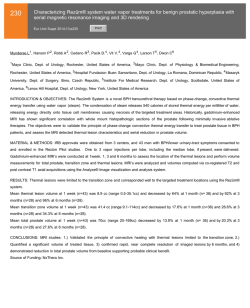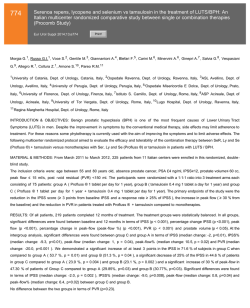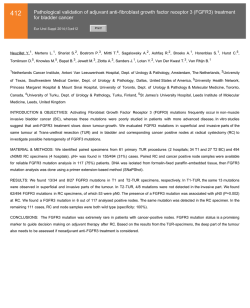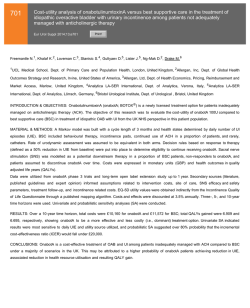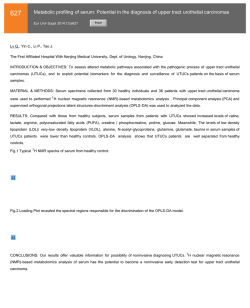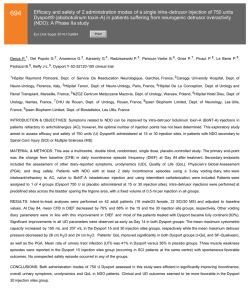
116 Chemoinduced downstaging as a potential surrogate marker of
116 Chemoinduced downstaging as a potential surrogate marker of efficacy and of increased survival following neoadjuvant chemotherapy of locally advanced urothelial urinary bladder cancer Eur Urol Suppl 2014;13;e116 Print! Print! Rosenblatt R.1 , Sherif A. 2 , Rintala E. 3 , Wahlqvist R.4 , Ullén A. 5 , Nilsson S. 5 , Malmström P-U.6 1 Södersjukhuset, Karolinska Institutet, Dept. of Urology, Stockholm, Sweden, 2 Umeå University Hospital, Institution of Perioperative Sciences, Dept. of Urology and Andrology, Umeå, Sweden, 3 Helsinki University Hospital, Dept. of Urology, Helsinki, Finland, 4 Oslo University Hospital, Dept. of Urology, Oslo, Norway, 5 Radiumhemmet, Karolinska Institutet, Dept. of Oncology, Stockholm, Sweden, 6 Uppsala Akademiska Sjukhus, Dept. of Urology, Uppsala, Sweden INTRODUCTION & OBJECTIVES: Defining responders and nonresponders to neoadjuvant chemotherapy is important for minimizing overtreatment and unnecessary delay to definitive treatment of urothelial urinary bladder cancer (UBC). Hypothetically downstaging of the primary tumour can be considered as being a surrogate marker of treatment efficacy on micrometastatic dissemination. Thus our main objective was to assess the effect of neoadjuvant chemotherapy on tumour downstaging and on overall survival in patients with locally advanced UBC. MATERIAL & METHODS: 449 eligible patients (T2-T4aNXM0) from the randomised prospective Nordic Cystectomy Trials 1&2 were analysed retrospectively.Eligible patients were defined as T2-T4aN0M0 preoperatively and pT0-pT4aN0-N1M0 postoperatively (TNM 1982,UICC). Median follow up time was 5 years. The experimental arm consisted of cisplatin based neoadjuvant chemotherapy and the control arm of cystectomy only. Patients from Nordic Cystectomy Trial 1 had also received suboptimal preoperative doses of radiation therapy in both trial arms. All patients randomized in both cystectomy trials, had undergone limited nodal dissection. Primary outcome was tumour downstaging defined as pathologic TNM < Clinical TNM. Different downstaging thresholds were applied: Complete downstaging (pT0N0), non-invasive downstaging (pT0/pTis/pTaN0) and organ confinement (≤pT2bN0). Downstaging rates were compared between the treatment arms with chi square test. Secondary outcome was overall survival stratified by treatment arm, downstaging categories and clinical stage. Downstaging as prognostic factor was analysed by Kaplan-Meier and Cox regression models. RESULTS: Downstaging rates increased significantly in the neoadjuvant arm independently of downstaging threshold. The impact was more prominent in clinical T3 tumours with a near threefold increase of pT0N0 tumours. The combination of downstaging plus neoadjuvant chemotherapy showed a 31% increase in overall survival at 5 years compared to downstaging controls. The combination of neoadjuvant chemotherapy + complete downstaging showed a hazard ratio of 0.32 compared to 1.0 for the combination of no-neoadjuvant chemotherapy and no-complete downstaging. The results were limited by the retrospective nature of the material and uncertainty of clinical TNM staging. CONCLUSIONS: Survival benefits observed following neoadjuvant chemotherapy in muscle invasive urothelial urinary bladder cancer is reflected in downstaging of the primary tumour. Hypothetically, downstaging of the primary tumour can be considered as being a surrogate marker of treatment efficacy on micrometastatic dissemination. Thus chemoinduced downstaging can be regarded as a potential surrogate marker for chemosensitivity and overall survival. This might be useful for clinical monitoring of the disease, differentiation between responders versus nonresponders and development of hypothetical models for treatment selection.
© Copyright 2025
